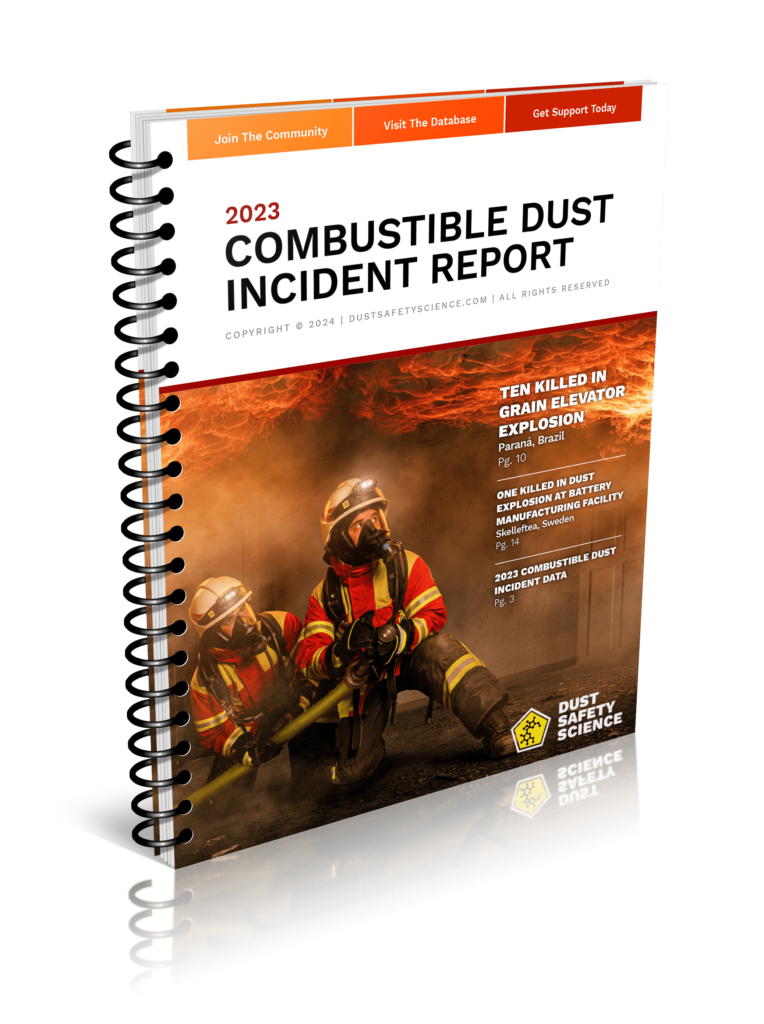This page provides a live-time summary of our incident reporting for the current 2023 calendar year and is updated on a quarterly basis. On an annual basis, we combine all the incidents into an annual report summarizing the materials, industries and equipment involved in explosions around the world.
Download a free copy of all the incident reports by subscribing on the signup page below:
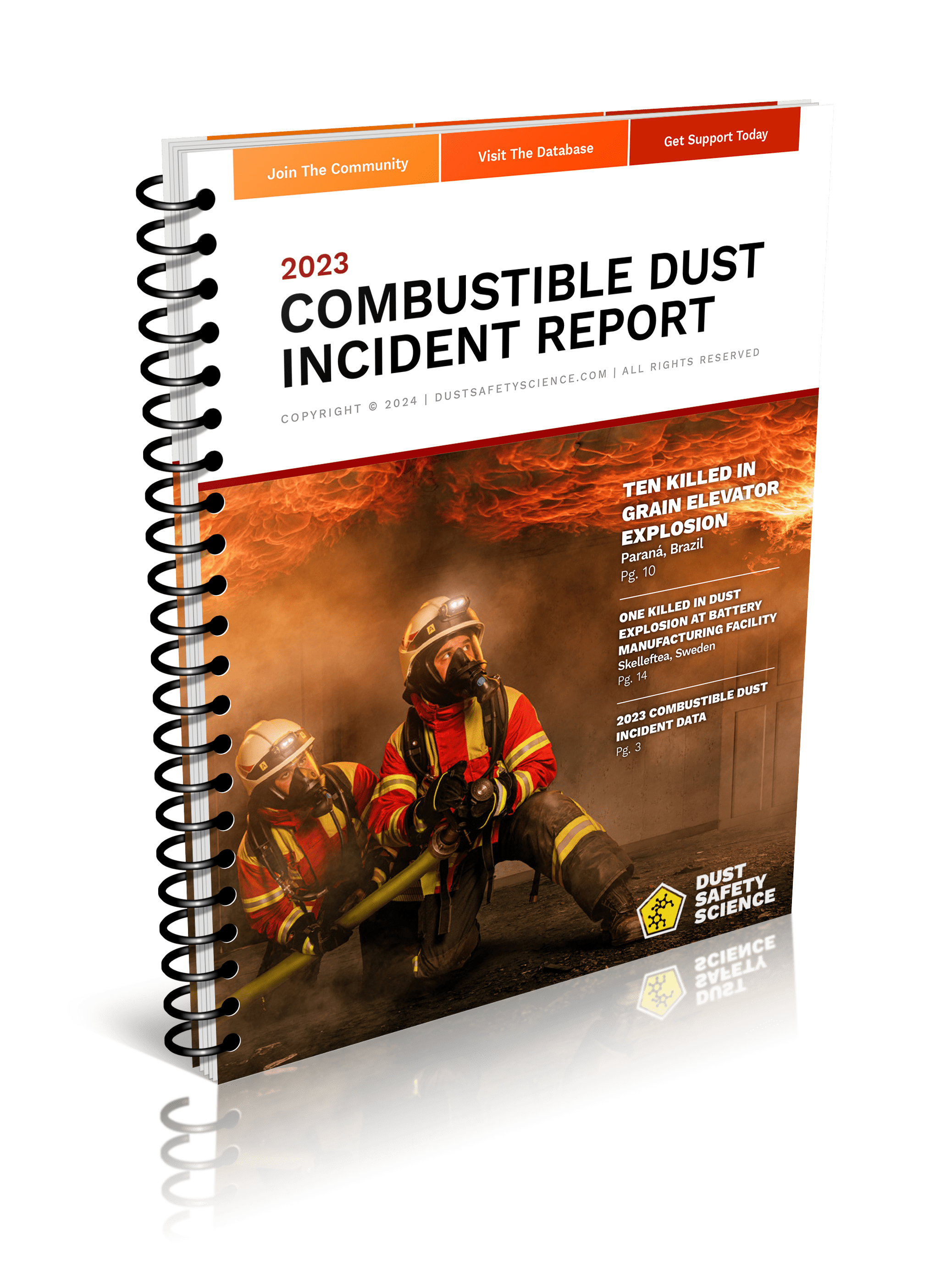
How many Combustible Dust Explosions have happened around the world in 2023?
Between January 1st, 2023, and January 1st, 2024 the Dust Safety Science team has recorded 263 Fires, 53 Explosions, 94 Injuries and 62 Fatalities related to combustible dust around the world. You can see the tracking on a month-by-month basis in the image below.
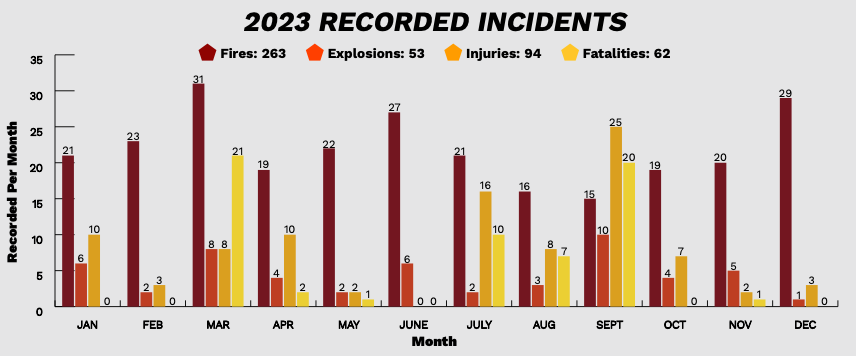
We have been recording combustible dust incidents as part of DustSafetyScience.com since 2016. The following table compares the number of incidents, injuries and fatalities entered into the database between 2019 and 2023.

How Many Combustible Dust Explosions Happen in the United States Each Year?
Loss history from dust explosions in the United States over the last eight years is given in the following table. This data has been collected in the incident database and reported in the 2016 to 2023 combustible dust incident reports.
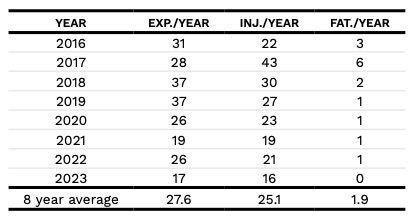
This data gives an average of 28 dust explosions per year, 25 injuries and a range from one to six yearly fatalities over the last eight years. Note that dust fires are excluded in this analysis.
2023 Global Loss Overview
In 2023, 66% of the fatalities recorded occurred due to dust explosions. Of the injuries, 86% occurred due to explosions and 14% occurred due to fires.
Some of the more severe incidents include:
- 20 Injured and killed in grain dust explosion (Parana, Brazil)
- Eight injured in grain processing explosion (Decatur, Il)
- One in critical condition from steel dust explosion (Muncie, IN)
- 21 killed in coal mine explosion (Sutatausa, Colombia)
Limited information has been available for damages from dust explosions and fires. From the information that is available the following incidents resulted in more than $1,000,000 in losses:
- $10m damages from sewage sludge explosion (Baltimore, MD)
- $1.1m damages from wood dust explosion (Wismar, Germany)
- $1m € damages in mill explosion (Wallenrod, Germany)
What materials are most commonly involved in Combustible Dust Explosions and Combustible Dust Fires?
From the global incident data, food and wood products made up 79% of the fires and explosions recorded, 76% of the injuries and 24% of the fatalities. The largest-loss agricultural disaster was a grain dust explosion in Brazil that killed 10 and injured 10 more.
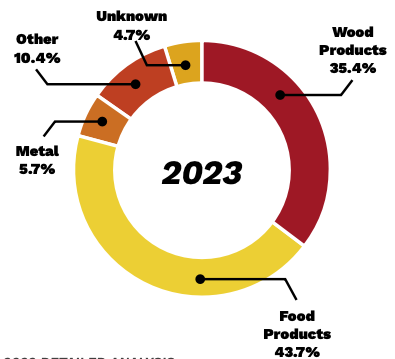
Coal was the most deadly material this year, accounting for 68% of this year’s fatalities, despite accounting for only 3.5% of the recorded incidents. This is largely due to a tragic mine explosion in Sutatausa, Columbia and fires in Panguan, China and Karaganda, Kazakhstan. A breakdown of the fires, explosions, injuries and fatalities for each type of material is given as follows:
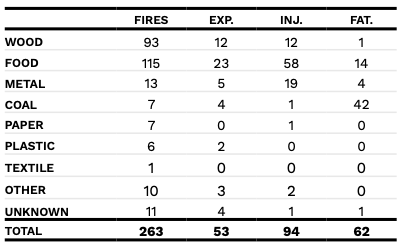
Fatal explosions involving metal this year included an aluminum melting furnace in Brazil, and an explosion during a 3D printing dust collector filter exchange
in Shanghai, China. A paper products facility fire in Washington and a coal dust explosion in West Virginia contributed one injury each.
Under the category “unknown” and “other”, 4 injuries
and one fatality resulted from one explosion at a battery manufacturing plant in Sweden and three fires in a laundry facility, tire manufacturing facility and storage silo fire, respectively.
What industries are most commonly involved in Combustible Dust Explosions and Combustible Dust Fires?
As shown in the historical data, wood processing, wood products, agricultural activity and food production make up a large portion of the overall fire and explosion incidents. Since 2020 wood and wood products
have ranged from 18% to 28% of the incidents, while agricultural activity and food production has ranged from 44% to 50%
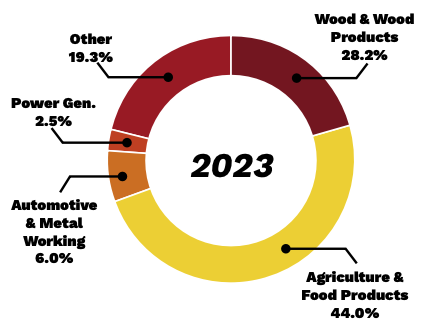
As shown in the detailed incident breakdown, the “other” category includes pulp & paper, ethanol, mining, coal handling, high schools, and educational facilities. Industries not broken out in the detailed breakdown include rubber products, chemical processing, plastics and waste treatment.
In 2023, mining and industries handling coal made up 68% of the fatalities. Agriculture and food processing made up 62% of the injuries and 22% of the fatalities. Automotive and metalworking made up 18% of the injuries and 3% of the fatalities, while wood & wood products industries made up 11% of the injuries and 2% of the fatalities.:
What Equipment is most commonly involved in Combustible Dust Explosions and Combustible Dust Fires?
In 2023, storage silos demonstrated the highest percentage (36%) of combustible dust incidents with 93 fires and 20 explosions reported. Dryers and dust collectors were the next biggest sources of incidents, accounting for 18% and 13% each.

Only three dust collector explosions were recorded in 2023 compared to 10 in 2022. These included a flash fire which occurred during a filter change at a 3D printing facility in Shanghai that killed two workers and injured two more, and a dust collector explosion in Wismar, Germany that injured two. A full breakdown of fires, explosions, and loss can be seen in the table below:
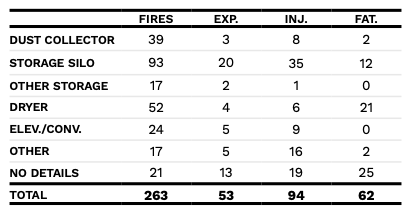
Of the incidents where the equipment is known, 21
fatalities came from elevators/conveyors, 10 from storage silos, two from dust collectors and two from an aluminum melting furnace explosion. The 21 fatalities from conveyor belt systems are attributed to two coal mine fires in Panguan, China and Karaganda, Kazakhstan, respectively.
Incidents where no details were provided for the equipment made up only 11% of the total reported. However, these incidents made up 20% of the reported injuries and 40% of the reported fatalities. These incidents included a coal dust explosion in a mine in Columbia, a sugar facility explosion in Tanzania, a housing materials facility explosion in Japan, a battery manufacturer explosion in Sweden, a grain dust explosion in Decatur, Illinois and a sawdust explosion at a molding manufacturer in the UK.
Disclaimer
The contents of the incident reports are generated using publicly available news articles and resources. The data is provided for informational purposes only and is not meant as a replacement for professional guidance. Due to reliance on third-party news agencies, incomplete articles, and limited analysis methods, DustEx Research Ltd. makes no warranties or guarantees to the accuracy or completeness of the information provided.
Want to download your own copy of the report?
Here is the link to the email signup page again in case you missed it the first time!
